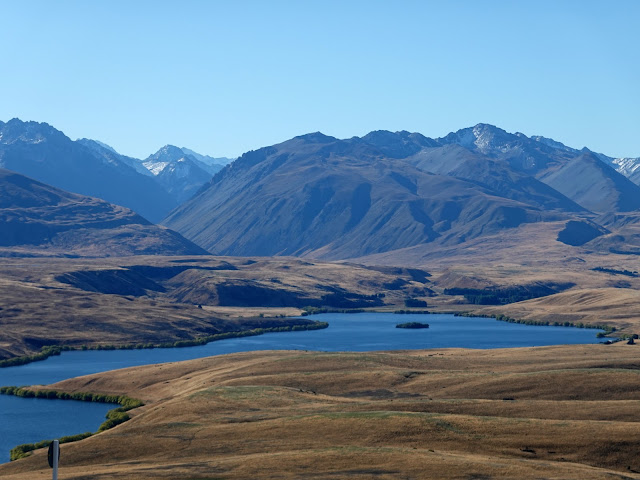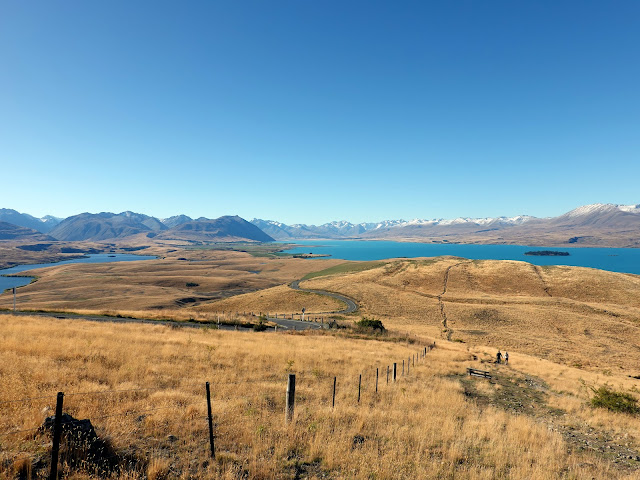Mount John 23-03-2023
This map was created using GPS Visualizer's do-it-yourself geographic utilities.
Please wait while the map data loads...
Route: Tekapo, Tekapo Springs, Mount John, Tekapo Mt John Walkway, Tekapo
Date: 23/03/2023
From: Tekapo
Parking: Tekapo Springs
Start Point: Tekapo Springs
Finish Point: Tekapo Springs
Region: Lake Tekapo
Route length: 8.5 km
Time taken: 02:00
Average speed: 4.9 km/h
Ascent: 376m
Descent: 385m
Points of Interest: Mount John, Lake TekapoMount John can be found at Tekapo in the Mackenzie area on New Zealand's South Island. Tekapo village is probably most famous for the dazzling blue lake, but it is also home to some of the best star gazing in the world thanks to its relative remoteness to light pollution. It is located within the Aoraki Mackenzie International Dark Sky Reserve, which is the largest dark sky reserve in the world. There are plenty of accommodation options in Tekapo if you're looking to use it as a base for a few days.
 |
| The Church of the Good Shepherd is a popular spot in Tekapo village |
So good are the dark skies that Mount John is home to the University of Canterbury's astronomy site, home to six telescopes including the largest in the country — more on those later.
The hike to the summit of Mount John forms part of a pleasant 8 km circuit that starts and ends in the village, visiting the summit of the hill and then returning along the shore of the lake. It is a perfect hike for the morning or late afternoon, as was my case.
The track begins at Tekapo Springs, where it climbs around the back of the spa complex until it enters the wooded hillside of Mount John. Here it winds its way uphill through the trees on a well-defined track, emerging on the tussock-covered hillside below the summit. This is easily the most challenging part of the hike, simply because it gains 150m in a short space of time.
 |
| Mount Edward (1,916m) |
 |
| Tekapo village |
 |
| The path from Tekapo Springs climbs the steep side of Mount John |
 |
| Mount John |
The observatory occupies the summit and is closed after 5pm to allow the safe operation of the telescopes. This doesn't prevent you from seeing any of the views, however. If you can't manage the hike or don't have the time, you can drive to the observatory by paying a modest fee to use the road. The Astro Café awaits you at the summit, where you can enjoy a coffee while marvelling at the views.
 |
| Views over the Mackenzie Basin |
 |
| Lake Tekapo |
 |
| The Mount John Observatory |
On the subject of the summit — the University of Canterbury owns the observatory atop Mount John, which is home to the 1.8m MOA telescope, the largest optical telescope in New Zealand. They operate tours through the Dark Sky Project, and we were lucky enough to spend some time at the observatory on a crystal-clear night that coincided with a strong Aurora Australis or, Southern Lights. The results were spectacular.
 |
| A strong Aurora Australis was on show when we visited the observatory |
 |
| The Milky Way over Tekapo |
 |
| The Astro Café atop Mount John |
Geologically (or glacialogically), Mount John is a roche moutonnée on a vast scale. These rock formations are created by the passage of glacial ice over underlying bedrock resulting in asymmetrical erosion as the ice is slowed on the upstream face of the rock and then accelerates over the downstream side.
The entire landscape of the MacKenzie region was shaped by the most recent Ice Age with glacial flooding creating the flat terrain in the Mackenzie Basin. Situated at an altitude exceeding 600 meters and located in the rain shadow of the mountains, the dry, and cold region surrounding Lake Tekapo experiences a climate similar to that of Siberia. It has extremely hot summers and freezing winters, with little rainfall. These factors contribute to the arid nature of the area.
The best view of the Mackenzie Basin is from the top of the track after it emerges from the woodland.
 |
| The view from the trail over the Mackenzie Basin |
 |
| The Mackenzie Basin |
The trail continues along the spine of Mount John, heading north down a fairly gentle slope. The views to the north are spectacular, encompassing Lake Tekapo, Lake Alexandrina, the Gamack and Hall Ranges and part of the Southern Alps.
 |
| Clouds spill through Tekapo Saddle |
 |
| Mount Ardmore (1,989m) |
 |
| Lake Tekapo and the Southern Alps |
 |
| Lake Alexandrina |
 |
| Descending from Mount John |
At the north end of Mount John, the path turns through 180 as it descends towards the lake and begins its route back towards Tekapo Springs. Here, you'll get the best of the views of Lake Tekapo.
 |
| Looking north across Lake Tekapo |
 |
| Motuariki Island and the Two Thumb Range |
 |
| The pleasing lines of the Sibbald Range, crowned by Mount Sibbald (2,811m) |
 |
| Descend off the north side of Mount John |
 |
| Motuariki Island and Mount Ardmore (1,989m) |
 |
| Tekapo village |
Lake Tekapo is one of three lakes that run roughly parallel along the northern edge of the Mackenzie Basin, the other two being Lake Pukaki and Lake Ohau. The lake is fed by water from the Southern Alps, specifically meltwater from the Grey Glacier, Classen Glacier and Godley Glacier (among other, smaller ones). The glacial silt carried in the water gives Lake Tekapo its distinctive colour.
 |
| Lake Tekapo |
The route back to the village follows the shoreline of the lake along the eastern side of Mount John. This section is fairly flat, all the way back to Tekapo Springs.
 |
| Lake Tekapo |
 |
| Clouds spill through Tekapo Saddle |
 |
| Lake Tekapo |
 |
| Tekapo village |
 |
| Lake Tekapo in Tekapo village |
The scenery around Mount John makes a climb to the summit well worth the effort. In addition, the summit of Mount John, with its observatory and state-of-the-art telescopes, offers a unique opportunity to explore the depths of the universe and witness the brilliance of the stars above. It seems Tekapo is fast trying to position itself as a main tourist destination on South Island, and I can see why. The scenery, both during the day and the night, is truly stunning.































Spectacular photos of a spectacular place
ReplyDeleteThanks!
DeleteBeautiful!
ReplyDelete